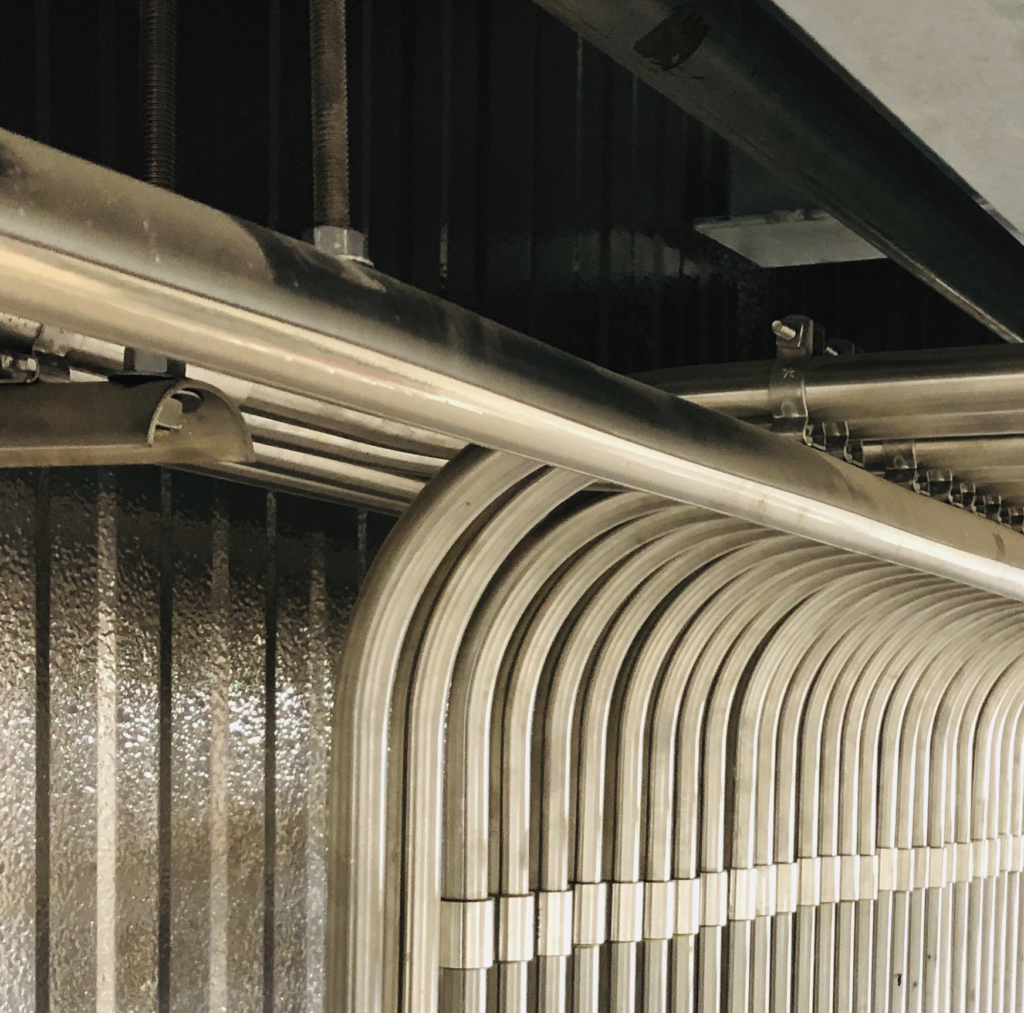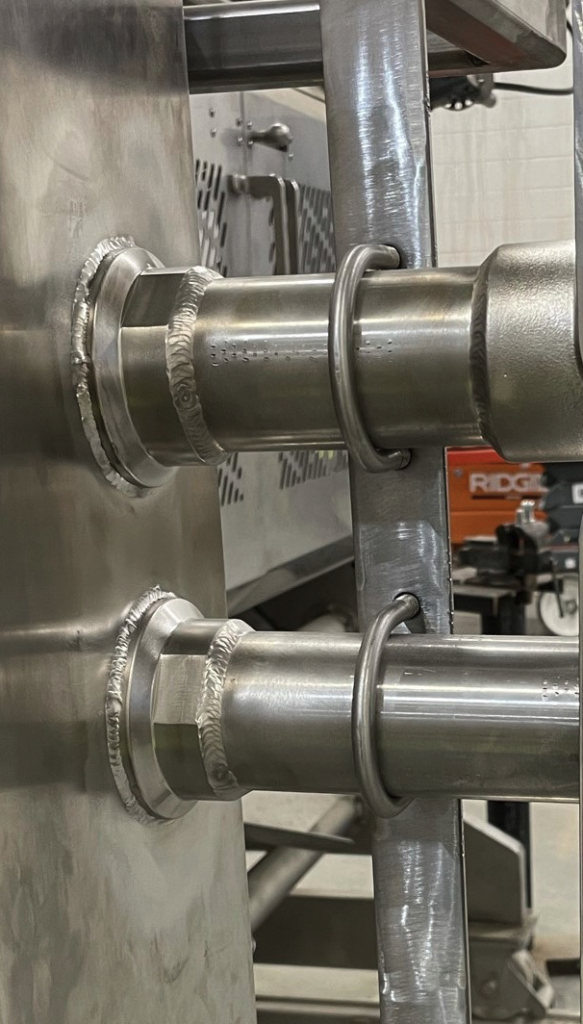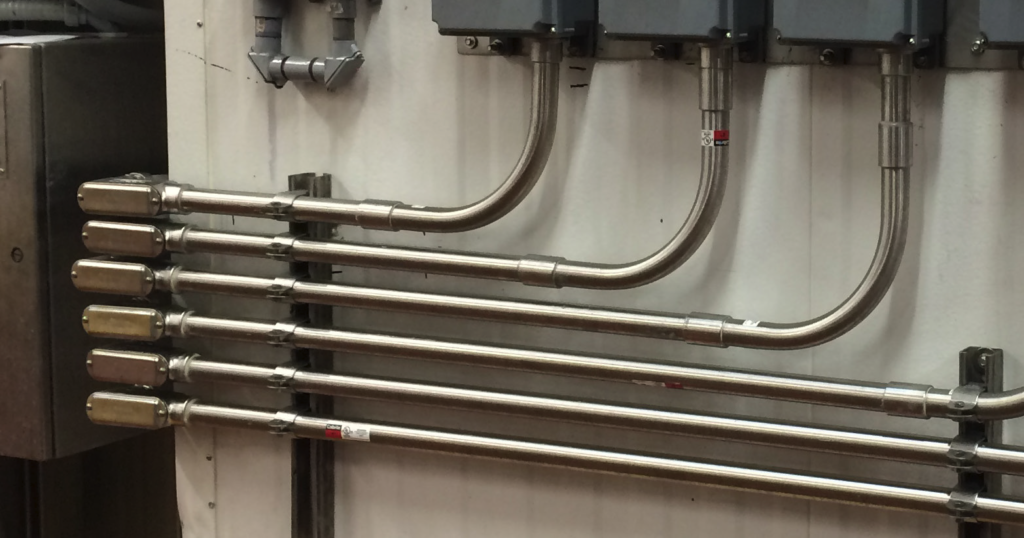Issues with Nonelectrical Piping and Tubing as Electrical Conduit
STAINLESS STEEL CONDUIT COMMITTEE, 2024
The installation of process piping as an alternative to electrical conduit is a long-standing problem. This paper seeks to inform the reader of problems associated with using piping systems that are not designed for use as electrical wiring methods.

I. THE LEGAL REQUIREMENTS

The use of nonelectrical piping or tubing, e.g., process piping or process tubing, is a violation of both the National Electrical Code® (NEC®) and federal requirements of the Occupational Safety and Health Administration (OSHA).
The National Electrical Code® is the standard for electrical installations in the United States and several countries throughout North, Central, and South America. It is legally adopted in all 50 states, and it requires, with rare exceptions, that electrical raceways and their associated fittings be listed. The term “raceway” is used in the NEC as a blanket term covering conduit, tubing, and other systems designed for holding electrical conductors; although this paper will use the words raceway, conduit, and tubing interchangeably. The term listed is defined in Article 100 of the NEC as, essentially, a product that has been tested and certified for compliance with an appropriate product standard by a qualified testing laboratory, such as UL or Intertek, thereby ensuring safety.
The safety regulations of OSHA standard 1910 Subpart S cover electrical installations in locations where people work as employees. Section 1910.303(a) indicates that “the conductors and equipment required or permitted by this subpart shall be acceptable only if approved, as defined in 1910.399.” The term approved is defined in 1910.399 as “…accepted, or certified, or listed, or labeled, or otherwise determined to be safe by a nationally recognized testing laboratory…”.
Note that the NEC definition of listed and the OSHA definition of approved are the same for all intents and purposes. Process piping is not listed (NEC) or approved (OSHA) and therefore violates both requirements.
II. WHY SOME THINK IT “DOESN’T MATTER” AND THE PERCEIVED ISSUE OF COST
There seem to be two main reasons process piping is sometimes used as an alternative to electrical conduit.
The first is the belief that it simply “doesn’t matter.” To many, the idea that “a pipe is a pipe is a pipe” and that “all pipes are created equal” is a sound opinion, and therefore, using the proper “pipe” is a non-issue. On its face, that argument is understandable, but it is not a defensible position.
The second reason is cost-related. When one holds the opinion that all pipes are one-and-the-same, the cost of the product is likely to be the main factor in the decision-making process. While process piping may be a less expensive alternative to a certified conduit system, the issue of cost is more complex than simply comparing the purchase price of the products.


III. WHY IT DOES MATTER AND THE REAL ISSUE OF COST
Process piping system used as raceway in violation of NEC and OSHA regulations
Comparing process piping and electrical conduit as though they are two different answers to the same question is fatally flawed. Process piping is designed to convey liquids and gases. Electrical conduits are designed to hold electrical conductors. The performance requirements for a vessel that holds liquids and gases are not the same as for a conduit that holds wires. While some of those requirements overlap, such as the desire for physical protection and corrosion-resistance, many, such as the ability to safely handle ground-fault current, do not.
An electrical conduit system will become energized when a ground-fault in the electrical system occurs, and, unlike process piping, the electrical conduit system is specifically designed to deal with that potentially deadly hazard. A ground-fault is an unintentional connection between an energized conductor and a metal object that is not intended to be energized, such as a conduit system. When a ground-fault occurs, hundreds, thousands, or even tens of thousands of Amperes of current flow on the metal objects that are temporarily energized. Although this massive amount of current on metal objects sounds (and is) dangerous, the current needs to be this high in order to quickly open a circuit breaker or fuse to remove the hazard. This large amount of current is only possible if the conduit system has a low value of electrical impedance. The mass of the conduit itself is of critical importance, as larger mass results in lower impedance and therefore yields higher current and a shorter duration of energized equipment. This concern is magnified when discussing stainless steel piping versus conduit because stainless steel has a higher impedance than traditional steel. Mass is not the only determining factor, however. The installation of the raceway must also be performed in a professional manner to ensure that all fittings and connections are tight and secure. But this only matters if the fittings and connections themselves are also designed to safely carry fault currents. If process piping is used, the piping itself has not been designed nor tested to carry large amounts of fault current and neither have the fittings. In lieu of fittings, process piping is often welded, which is even worse and is the subject of a separate paper.
The issue of cost is a common one. Today’s consumer expects their project to be completed on time and under budget. Initial cost can certainly be reduced by using substandard materials, but the long-term costs need to be evaluated as well. While process piping may initially be a cheaper alternative to electrical conduit, the initial cost reduction does not offset the value of using the right product. As previously mentioned, process piping is a 4
violation of both OSHA requirements and the NEC. The construction of a project needs to be inspected by a qualified electrical inspector to ensure compliance with the NEC, and the cost of replacing non-compliant materials as the result of a failed inspection is enormous. The installed cost of a substandard installation does not capture the total cost of ownership of the system, which can include poor performance and, worse, increased risk to property, personnel, etc. Cutting initial construction costs at the expense of the quality and safety of the completed installation is a fool’s errand. And what about the safety of the facility’s employees? A single lost-time incident resulting from an electric shock could, by itself, cost more than the savings generated by using substandard materials. Electric shock is not the only concern. When a ground-fault with high impedance occurs, arcing is the result. This arcing often results in fire, the cost of which can be a complete loss of the facility or even human life.


IV. CONCLUSION
The requirements of the Occupational Safety and Health Administration and the National Electrical Code have similar objectives, and they both exist for good reason. The owners of a facility, and those that work there, deserve not only a well-functioning installation but a safe one. The use of tested and certified electrical products ensures the practical safeguarding of the property and the persons associated with it.